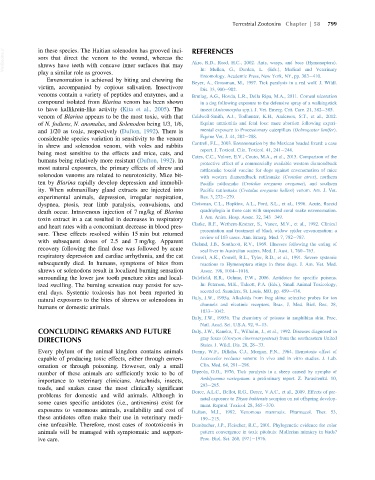Page 841 - Veterinary Toxicology, Basic and Clinical Principles, 3rd Edition
P. 841
Terrestrial Zootoxins Chapter | 58 799
VetBooks.ir in these species. The Haitian solenodon has grooved inci- REFERENCES
sors that direct the venom to the wound, whereas the
Akre, R.D., Reed, H.C., 2002. Ants, wasps, and bees (Hymenoptera).
shrews have teeth with concave inner surfaces that may
play a similar role as grooves. In: Mullen, G., Durden, L. (Eds.), Medical and Veterinary
Entomology. Academic Press, New York, NY, pp. 383 410.
Envenomation is achieved by biting and chewing the
Beyer, A., Grossman, M., 1997. Tick paralysis in a red wolf. J. Wildl.
victim, accompanied by copious salivation. Insectivore
Dis. 33, 900 902.
venoms contain a variety of peptides and enzymes, and a Brutlag, A.G., Hovda, L.R., Della Ripa, M.A., 2011. Corneal ulceration
compound isolated from Blarina venom has been shown in a dog following exposure to the defensive spray of a walkingstick
to have kallikrein-like activity (Kita et al., 2005). The insect (Anisomorpha spp.). J. Vet. Emerg. Crit. Care. 21, 382 385.
venom of Blarina appears to be the most toxic, with that Caldwell-Smith, A.J., Todhunter, K.H., Anderson, S.T., et al., 2012.
of N. fodiens, N. anomalus, and Solenodon being 1/3, 1/6, Equine amnionitis and fetal loss: mare abortion following experi-
and 1/20 as toxic, respectively (Dufton, 1992). There is mental exposure to Processionary caterpillars (Ochrogaster lunifer).
considerable species variation in sensitivity to the venom Equine Vet. J. 44, 282 288.
Cantrell, F.L., 2003. Envenomation by the Mexican beaded lizard: a case
in shrew and solenodon venom, with voles and rabbits
report. J. Toxicol. Clin. Toxicol. 41, 241 244.
being most sensitive to the effects and mice, cats, and
Cates, C.C., Valore, E.V., Couto, M.A., et al., 2015. Comparison of the
humans being relatively more resistant (Dufton, 1992). In
protective effect of a commercially available western diamondback
most natural exposures, the primary effects of shrew and
rattlesnake toxoid vaccine for dogs against envenomation of mice
solenodon venoms are related to neurotoxicity. Mice bit- with western diamondback rattlesnake (Crotalus atrox), northern
ten by Blarina rapidly develop depression and immobil- Pacific rattlesnake (Crotalus oreganus oreganus), and southern
ity. When submaxillary gland extracts are injected into Pacific rattlesnake (Crotalus oreganus helleri) venom. Am. J. Vet.
experimental animals, depression, irregular respiration, Res. 3, 272 279.
dyspnea, ptosis, rear limb paralysis, convulsions, and Chrisman, C.L., Hopkins, A.L., Ford, S.L., et al., 1996. Acute, flaccid
death occur. Intravenous injection of 7 mg/kg of Blarina quadriplegia in three cats with suspected coral snake envenomation.
toxin extract in a cat resulted in decreases in respiratory J. Am. Anim. Hosp. Assoc. 32, 343 349.
Clarke, R.F., Wethern-Kestner, S., Vance, M.V., et al., 1992. Clinical
and heart rates with a concomitant decrease in blood pres-
presentation and treatment of black widow spider envenomation: a
sure. These effects resolved within 15 min but returned
review of 163 cases. Ann. Emerg. Med. 7, 782 787.
with subsequent doses of 2.5 and 7 mg/kg. Apparent
Cleland, J.B., Southcott, R.V., 1969. Illnesses following the eating of
recovery following the final dose was followed by acute
seal liver in Australian waters. Med. J. Aust. 1, 760 763.
respiratory depression and cardiac arrhythmia, and the cat Cowell, A.K., Cowell, R.L., Tyler, R.D., et al., 1991. Severe systemic
subsequently died. In humans, symptoms of bites from reactions to Hymenoptera stings in three dogs. J. Am. Vet. Med.
shrews or solenodons result in localized burning sensation Assoc. 198, 1014 1016.
surrounding the lower jaw tooth puncture sites and local- Dalefield, R.R., Oehme, F.W., 2006. Antidotes for specific poisons.
ized swelling. The burning sensation may persist for sev- In: Peterson, M.E., Talcott, P.A. (Eds.), Small Animal Toxicology,
eral days. Systemic toxicosis has not been reported in second ed. Saunders, St. Louis, MO, pp. 459 474.
natural exposures to the bites of shrews or solenodons in Daly, J.W., 1995a. Alkaloids from frog skins: selective probes for ion
channels and nicotinic receptors. Braz. J. Med. Biol. Res. 28,
humans or domestic animals.
1033 1042.
Daly, J.W., 1995b. The chemistry of poisons in amphibian skin. Proc.
Natl. Acad. Sci. U.S.A. 92, 9 13.
CONCLUDING REMARKS AND FUTURE Daly, J.W., Kaneko, T., Wilhalm, J., et al., 1992. Diseases diagnosed in
DIRECTIONS gray foxes (Urocyon cinereoargenteus) from the southeastern United
States. J. Wildl. Dis. 28, 28 33.
Every phylum of the animal kingdom contains animals Denny, W.F., Dillaha, C.J., Morgan, P.N., 1964. Hemotoxic effect of
capable of producing toxic effects, either through enven- Loxesceles reclusus venom: in vivo and in vitro studies. J. Lab.
omation or through poisoning. However, only a small Clin. Med. 64, 291 298.
number of these animals are sufficiently toxic to be of Dipeolu, O.O., 1976. Tick paralysis in a sheep caused by nymphs of
importance to veterinary clinicians. Arachnids, insects, Amblyomma variegatum: a preliminary report. Z. Parasitenkd. 10,
293 295.
toads, and snakes cause the most clinically significant
Dorce, A.L.C., Bellot, R.G., Dorce, V.A.C., et al., 2009. Effects of pre-
problems for domestic and wild animals. Although in
natal exposure to Tityus bahiensis scorpion on rat offspring develop-
some cases specific antidotes (i.e., antivenins) exist for
ment. Reprod. Toxicol. 28, 365 370.
exposures to venomous animals, availability and cost of Dufton, M.J., 1992. Venomous mammals. Pharmacol. Ther. 53,
these antidotes often make their use in veterinary medi- 199 215.
cine unfeasible. Therefore, most cases of zootoxicosis in Dumbacher, J.P., Fleischer, R.C., 2001. Phylogenetic evidence for color
animals will be managed with symptomatic and support- pattern convergence in toxic pitohuis: Mullerian mimicry in birds?
ive care. Proc. Biol. Sci. 268, 1971 1976.

